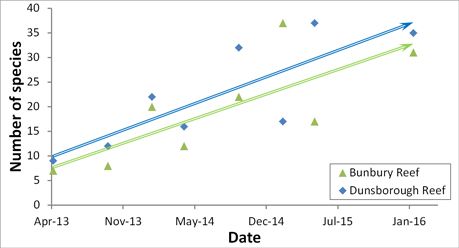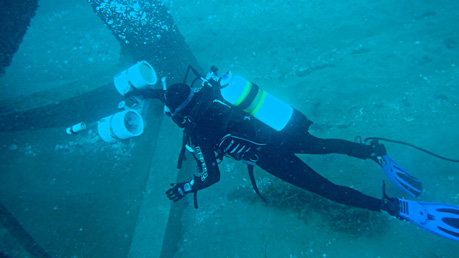As our research team anticipated, there has been a steady year-on-year increase of species and organisms observed on the artificial reefs.
As the tables below show, since the South West artificial reefs were deployed the number of fish species recorded on the reef structures has quadrupled from 12 to more than 50 species (52 species at Bunbury and 62 species at Dunsborough, at May 2015). However, up to the end of the second year of surveys, we recorded 165 different fish species on the natural areas surrounding the reefs, with 130 and 126 in the Bunbury and Dunsborough areas respectively.
The trial target species, pink snapper, silver trevally (skippy) and Samson fish, are all being found on the reefs regularly since the modules were installed.
Timeline showing number of species observed on Dunsborough and Bunbury artificial reef
There are particularly strong numbers of Samson fish at the Dunsborough reef with schools of up to 60 fish in and around the reefs regularly recorded on underwater cameras. A community of benthic organisms (those found on or near the ocean floor) have been developing on the reefs over the first two years and are beginning to resemble some of the other artificial reefs in the area, such as the HMAS Swan and Busselton Jetty. A variety of organisms including ascidians, bryozoans, sponges, macroalgae and some soft corals have colonised the structures.
A detailed summary of the latest monitoring results can be found in the appendices of our Status reports of the fisheries and aquatic resources of Western Australia.
Monitoring methods
The monitoring plan was designed by a scientific reference group, made up of representatives from a number of research institutes and government agencies to ensure the following objectives are met:
The project’s success in providing recreational fishing opportunities is assessed.
The surrounding areas are monitored for any positive or negative impacts caused by the artificial reefs.
The modules’ structural integrity is monitored to check they are remaining in place and not breaking up.
Any accumulations of fishing debris (line, hooks, sinkers, anchors and ropes) on the reefs is monitored and removed.

Monitoring the artificial reefs using a Diver Operated Video (DOV).
The reefs are being monitored by baited remote underwater video (BRUV), diver operated video (DOV) and side scan sonar surveys. These methods allow us to assess the diversity, abundance and size of the fish found on the artificial reef modules and in the surrounding natural areas.
They also allow us to keep a record of the modules’ position, structural integrity and degree of fishing debris accumulation.